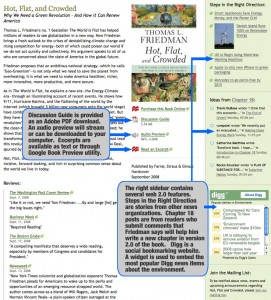 What do you get when a book becomes web 2.0? The answer is a website that is used to sell the book, but more importantly allows readers to share their responses to the book’s content. A great example of this phenomena is the publication of Thomas Friedman’s new book, Hot, Flat, and Crowded. [September, 2008]
What do you get when a book becomes web 2.0? The answer is a website that is used to sell the book, but more importantly allows readers to share their responses to the book’s content. A great example of this phenomena is the publication of Thomas Friedman’s new book, Hot, Flat, and Crowded. [September, 2008]
Friedman is best known for his 2005 book, The World Is Flat. The book was a major influence in the world of educational technology since it effectively outlined the connection between education and the ability to prepare people (especially students) for 21st century jobs. There was an explosion of “flat” references in education journals and magazines, and education conference sessions. I created a Apple Keynote presentation, Malden Could be Flat, to introduce educators in Malden Public Schools to the major concepts in the book. The presentation was converted to run in Flash and streams from an Adobe Connect Pro server account. The first slide includes a brief audio introduction and then it’s up to the viewer to click through the content. The World is Flat is currently available as a 3.0 version. Friedman uses the same version protocol favored by the software industry to provide updates to his books.
Back to Hot, Flat, and Crowded. As I try to explain the world of web 2.0 to teachers, it is important to understand the major shift occuring in the world of book publication. Namely, books must adapt to new patterns of information consumption. Teachers have increasingly experienced this shift when they open new boxes of textbooks to find multimedia DVDs and instructions to access online content. Like Friedman’s new book, modern textbooks have entire websites backing up their static, printed content. What types of web 2.0 examples are found on Friedman’s site? If you don’t have time to read, but would like to listen to Hot, Flat, and Crowded while stuck in traffic you can download an audio version of the book. An audio preview is provided as an mp3 download.
Chapter two makes the distinction between “fuels from hell” and “fuels from heaven.” How is your life fueled by both categories? What would it take to transition completely to “fuels from heaven”? -Hot, Flat, and Crowded discussion guide
Teachers will appreciate the Discussion Guide that provides thought provoking questions about each chapter. High School teachers could turn these questions into a web 2.0 assignment by having students read the book and share their responses with international students. [The flatclassroom project is great model.] The right sidebar contains the most relevant web 2.0 content since it appears based on the actions of people that Friedman doesn’t control. At the top of the page, Steps in the Right Direction are links to sites supporting the themes in the book. I still can’t believe that you can wash a load of clothes with a cup of water! The article titles are most likely selected based on a set of filters Friedman uses to consume RSS feeds. The Chapter 18 comments are posts from readers who have been asked to contribute ideas for the 2.0 version of the book. I would like to see students post comments here. The final web 2.0 example involves embedding what is known as a widget to display the top five web-based articles under the topic of the environment. Digg is one of several popular social bookmarking sites. What ideas do you have for helping students make their own web 2.0 books?




